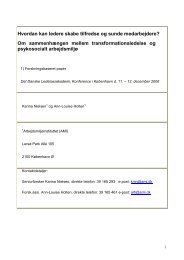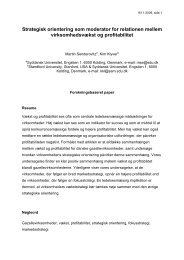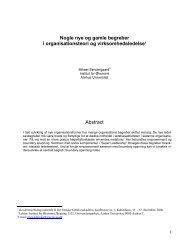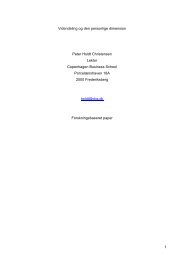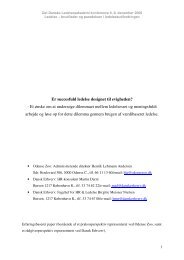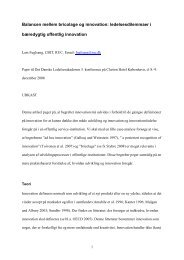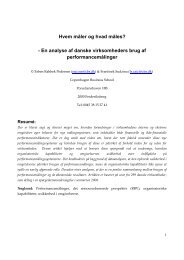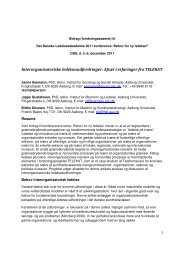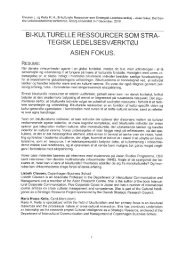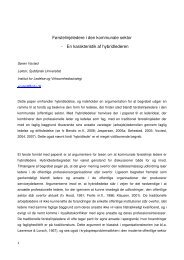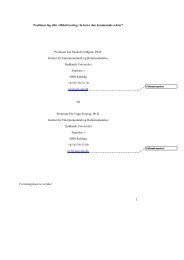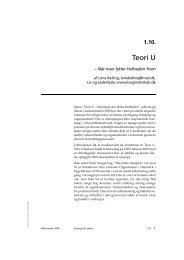Change management in public reforms - Det Danske ...
Change management in public reforms - Det Danske ...
Change management in public reforms - Det Danske ...
You also want an ePaper? Increase the reach of your titles
YUMPU automatically turns print PDFs into web optimized ePapers that Google loves.
<strong>Change</strong> Management <strong>in</strong> Public Reforms 2006In this view, signs of <strong>in</strong>ertia may not necessarily be products of resistance but rather theproducts of loyalty to the organization. Loyalty which is essential <strong>in</strong> <strong>public</strong> <strong>management</strong>given its <strong>in</strong>fluence on predictability which aga<strong>in</strong> is a precondition for the democraticfunction of <strong>public</strong> organizations. Therefore, a mis<strong>in</strong>terpretation of behavior by employeesor other managers <strong>in</strong> this respect can be very unfortunate for those be<strong>in</strong>g misunderstoodas well as for those who mis<strong>in</strong>terpreted the signals. As a result of such amisunderstand<strong>in</strong>g, the mis<strong>in</strong>terpretation may <strong>in</strong> the end be self fulfill<strong>in</strong>g.Moral order of an organization is vulnerable dur<strong>in</strong>g vast reorganizations such as <strong>public</strong><strong>management</strong> <strong>reforms</strong>. As described earlier, reform is an organizational crisis which shakesthe organization and its members. In vast reorganizations, the moral order will be fragiledue to the lack of stability and certa<strong>in</strong>ty:A crisis renders all obligations and promises suspect, because the organization as awhole has an uncerta<strong>in</strong> future. (Hirschhorn, 2000, p. 165)People <strong>in</strong> an organizational crisis are generally heavily affected by these changes <strong>in</strong> whatHirschhorn describes as obligations and promises between the organization and the<strong>in</strong>dividual. However, people <strong>in</strong> the organization tend to hold on to the moral order as far asthey possibly can.People rel<strong>in</strong>quish a moral order only when it has seriously lost legitimacy, when it isno longer experienced as an arrangement that secures its members’ future.(Hirschhorn, 2000, p. 164-165)This quote shows that people try to reta<strong>in</strong> the moral order of the organization for as long aspossible. However, follow<strong>in</strong>g the statement on the dynamics of moral order, we can alsoconclude that people cannot susta<strong>in</strong> a moral order when faced with <strong>in</strong>security and lack offuture scenarios. Therefore, when <strong>in</strong>itiat<strong>in</strong>g vast reorganizations, the risk <strong>in</strong>volved <strong>in</strong>remov<strong>in</strong>g the exist<strong>in</strong>g moral order and remov<strong>in</strong>g the projected images of futureorganization from employees should be taken <strong>in</strong>to consideration. Particularly <strong>in</strong> <strong>public</strong>sector organizations for which stability is a precondition for its function – and ever moreimportant <strong>in</strong> organizations such as the police that has high social capital.Public <strong>management</strong> reform risks compromis<strong>in</strong>g the moral order of the organization. People<strong>in</strong> the organization will try to cl<strong>in</strong>g to the exist<strong>in</strong>g moral order – whether managers orRex Degnegaard Page 11 of 14



